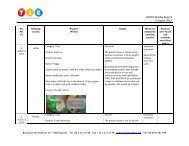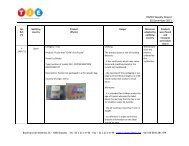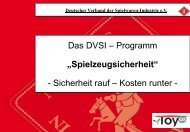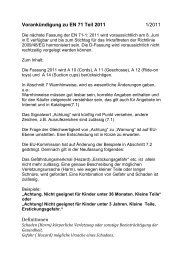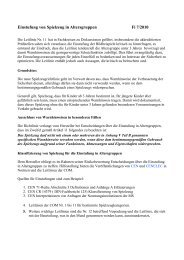Create successful ePaper yourself
Turn your PDF publications into a flip-book with our unique Google optimized e-Paper software.
<strong>EN</strong> <strong>71</strong>-1:<strong>2005+</strong><strong>A8</strong>:2009 (E)<br />
The stability requirements do not apply to products which are not intended to be stable in their own right, e.g.<br />
pogo sticks.<br />
Hand carts are wheeled toys in which one or more children may sit while being pulled along by another child<br />
or an adult.<br />
If a toy which is designed to bear the weight of a child allows the child to use its feet to provide stability, the<br />
requirements do not apply. If the child is completely enclosed, the requirements should apply. It is a natural<br />
reaction for children to stabilise a toy with their feet when possible. However, the stability requirements apply<br />
to all toys intended for children under 36 months unless specifically excluded.<br />
The braking requirements specify brakes for all ride-on toys with a free-wheeling facility. Toys with a direct<br />
transmission are excluded from these requirements, e.g. certain tricycles with pedals on the front wheel, pedal<br />
cars and also electrically driven cars with low speed (i.e. < 1 m/s) where the child's feet are free and can be<br />
used to brake the vehicle.<br />
In assessing free-wheeling capability, it is often convenient and more practical to test the toy on a slope and<br />
establish whether it accelerates down the slope. Only in case of uncertainty, it should be necessary to use the<br />
formula. The complete formula for calculating the free-wheeling facility is (M + 25) x g x sin 10°. Sin 10°<br />
equals 0,173 and multiplied by 9,81 it equals 1,70.<br />
There are no speed limitations in the standard for electrically driven toys intended for children over 3 years.<br />
However, certain countries may have such limitations in their national legislation.<br />
A.21 Rocking horses and similar toys (see 4.15.3)<br />
-The requirements are intended to address the hazards associated with insufficient strength and stability of<br />
rocking horses and similar toys that might overturn unexpectedly. They also aim at warning supervising adults<br />
that children under 36 months should not be left unattended on rocking toys with a seat height over 600 mm,<br />
to avoid the risk of falls and injury..<br />
A.22 Projectiles (see 4.17)<br />
These requirements are intended to address certain but not all potentially unexpected hazards associated with<br />
projectile firing toys and by the firing of improvised projectiles from such toys.<br />
A toy in which the kinetic energy is determined by the toy and not by the child is typically a gun or other<br />
spring-loaded device. A pea-shooter is an example of a toy with a projectile (a pea) of which the kinetic energy<br />
is determined by the child by blowing.<br />
Ground-based vehicular toys propelled along a track or other surface are not considered as projectile toys<br />
even if they include an element of motion in free-flight, e.g. between tracks.<br />
The velocity of projectiles may be measured by direct or indirect means.<br />
Projectiles with suction cups have been involved in accidents, and it is important that the length of these<br />
projectiles is sufficient to aid removal if it is blocking the airway.<br />
A.23 Aquatic toys (see 4.18 and 7.4)<br />
These requirements are intended to address the hazards associated with the sudden loss of buoyancy of<br />
inflatable aquatic toys if air is released through the inlet with drowning as a possible consequence. They also<br />
aim at informing adults and children of the dangers of using these toys in deep water. The standard covers<br />
inflatable toys intended to bear the mass of a child and used for play in shallow water and generally under the<br />
supervision of an adult.<br />
82



